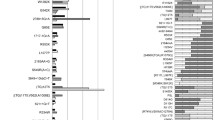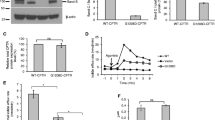Abstract
In order to further elucidate the contribution of complex alleles to the wide phenotypic variability of cystic fibrosis (CF), we investigated the structure-function relationships of a severe CF-associated complex allele [p.S912L;p.G1244V]. To evaluate the contribution of each mutation to the phenotype, cystic fibrosis transmembrane conductance regulator (CFTR) mutants were expressed in HeLa cells and analysed for protein processing and Cl− channel activity. Both p.G1244V and [p.S912L;p.G1244V] mutants had normal protein processing but markedly decreased Cl− channel activity compared with wild-type. Notably, the double mutant displayed a dramatic decrease in Cl− channel activity compared with p.G1244V (P<0.001). p.S912L had normal protein processing and no detectable impact on CFTR function. In other respects, the p.S912L variation was identified in compound heterozygosity with p.R709X in a healthy fertile man. Together, these data strongly support the view that p.S912L in isolation should be considered as a neutral variant but one that might significantly impair CFTR function when inherited in cis with another CFTR mutation. Our data also further document the contribution of complex alleles to the wide phenotypic variability of CF. The results of functional studies of such complex alleles in other genetic diseases are discussed.



Similar content being viewed by others
References
Anderson MP, Welsh MJ (1992) Regulation by ATP and ADP of CFTR chloride channels that contain mutant nucleotide-binding domains [published erratum appears in Science (1992) 258:1719]. Science 257:1701–1704
Baroudi G, Acharfi S, Larouche C, Chahine M (2002) Expression and intracellular localization of an SCN5A double mutant R1232W/T1620M implicated in Brugada syndrome. Circ Res 90:E11–E16
Bombieri C, Benetazzo M, Saccomani A, Belpinati F, Gile LS, Luisetti M, Pignatti PF (1998) Complete mutational screening of the CFTR gene in 120 patients with pulmonary disease. Hum Genet 103:718–722
Bonizzato A, Bisceglia L, Marigo C, Nicolis E, Bombieri C, Castellani C, Borgo G, Zelante L, Mastella G, Cabrini G, et al (1995) Analysis of the complete coding region of the CFTR gene in a cohort of CF patients from north-eastern Italy: identification of 90% of the mutations. Hum Genet 95:397–402
Caciotti A, Bardelli T, Cunningham J, D’Azzo A, Zammarchi E, Morrone A (2003) Modulating action of the new polymorphism L436F detected in the GLB1 gene of a type-II GM1 gangliosidosis patient. Hum Genet 113:44–50
Casals T, Bassas L, Ruiz-Romero J, Chillon M, Gimenez J, Ramos MD, Tapia G, Narvaez H, Nunes V, Estivill X (1995) Extensive analysis of 40 infertile patients with congenital absence of the vas deferens: in 50% of cases only one CFTR allele could be detected. Hum Genet 95:205–211
Chen JM, Cutler C, Jacques C, Boeuf G, Denamur E, Lecointre G, Mercier B, Cramb G, Ferec C (2001) A combined analysis of the cystic fibrosis transmembrane conductance regulator: implications for structure and disease models. Mol Biol Evol 18:1771–1788
Clain J, Fritsch J, Lehmann-Che J, Bali M, Arous N, Goossens M, Edelman A, Fanen P (2001) Two mild cystic fibrosis-associated mutations result in severe cystic fibrosis when combined in cis and reveal a residue important for cystic fibrosis transmembrane conductance regulator processing and function. J Biol Chem 276:9045–9049
Claustres M, Guittard C, Bozon D, Chevalier F, Verlingue C, Ferec C, Girodon E, Cazeneuve C, Bienvenu T, Lalau G, Dumur V, Feldmann D, Bieth E, Blayau M, Clavel C, Creveaux I, Malinge MC, Monnier N, Malzac P, Mittre H, Chomel JC, Bonnefont JP, Iron A, Chery M, Georges MD (2000) Spectrum of CFTR mutations in cystic fibrosis and in congenital absence of the vas deferens in France. Hum Mutat 16:143–156
Costes B, Girodon E, Ghanem N, Chassignol M, Thuong NT, Dupret D, Goossens M (1993) Psoralen-modified oligonucleotide primers improve detection of mutations by denaturing gradient gel electrophoresis and provide an alternative to GC-clamping. Hum Mol Genet 2:393–397
Devoto M, Ronchetto P, Fanen P, Orriols JJ, Romeo G, Goossens M, Ferrari M, Magnani C, Seia M, Cremonesi L (1991) Screening for non-delta F508 mutations in five exons of the cystic fibrosis transmembrane conductance regulator (CFTR) gene in Italy. Am J Hum Genet 48:1127–1132
Dork T, Wulbrand U, Richter T, Neumann T, Wolfes H, Wulf B, Maass G, Tummler B (1991) Cystic fibrosis with three mutations in the cystic fibrosis transmembrane conductance regulator gene. Hum Genet 87:441–446
Duarte A, Amaral M, Barreto C, Pacheco P, Lavinha J (1996) Complex cystic fibrosis allele R334W-R1158X results in reduced levels of correctly processed mRNA in a pancreatic sufficient patient. Hum Mutat 8:134–139
Fanen P, Ghanem N, Vidaud M, Besmond C, Martin J, Costes B, Plassa F, Goossens M (1992) Molecular characterization of cystic fibrosis: 16 novel mutations identified by analysis of the whole cystic fibrosis conductance transmembrane regulator (CFTR) coding regions and splice site junctions. Genomics 13:770–776
Fanen P, Labarthe R, Garnier F, Benharouga M, Goossens M, Edelman A (1997) Cystic fibrosis phenotype associated with pancreatic insufficiency does not always reflect the cAMP-dependent chloride conductive pathway defect. Analysis of C225R-CFTR and R1066C-CFTR. J Biol Chem 272:30563–30566
Fanen P, Clain J, Labarthe R, Hulin P, Girodon E, Pagesy P, Goossens M, Edelman A (1999) Structure-function analysis of a double-mutant cystic fibrosis transmembrane conductance regulator protein occurring in disorders related to cystic fibrosis. FEBS Lett 452:371–374
Ghanem N, Costes B, Girodon E, Martin J, Fanen P, Goossens M (1994) Identification of eight mutations and three sequence variations in the cystic fibrosis transmembrane conductance regulator (CFTR) gene. Genomics 21:434–436
Grace ME, Ashton-Prolla P, Pastores GM, Soni A, Desnick RJ (1999) Non-pseudogene-derived complex acid beta-glucosidase mutations causing mild type 1 and severe type 2 Gaucher disease. J Clin Invest 103:817–823
Hojo S, Fujita J, Miyawaki H, Obayashi Y, Takahara J, Bartholomew DW (1998) Severe cystic fibrosis associated with a deltaF508/R347H + D979A compound heterozygous genotype. Clin Genet 53:50–53
Kiesewetter S, Macek M Jr, Davis C, Curristin SM, Chu CS, Graham C, Shrimpton AE, Cashman SM, Tsui LC, Mickle J, et al (1993) A mutation in CFTR produces different phenotypes depending on chromosomal background. Nat Genet 5:274–278
Mercier B, Verlingue C, Lissens W, Silber SJ, Novelli G, Bonduelle M, Audrezet MP, Ferec C (1995) Is congenital bilateral absence of vas deferens a primary form of cystic fibrosis? Analyses of the CFTR gene in 67 patients. Am J Hum Genet 56:272–277
Monplaisir N, Merault G, Poyart C, Rhoda MD, Craescu C, Vidaud M, Galacteros F, Blouquit Y, Rosa J (1986) Hemoglobin S Antilles: a variant with lower solubility than hemoglobin S and producing sickle cell disease in heterozygotes. Proc Natl Acad Sci USA 83:9363–9367
Riordan JR, Rommens JM, Kerem B, Alon N, Rozmahel R, Grzelczak Z, Zielenski J, Lok S, Plavsic N, Chou JL, et al (1989) Identification of the cystic fibrosis gene: cloning and characterization of complementary DNA [published erratum appears in Science (1989) 245:1437]. Science 245:1066–1073
Romey MC, Pallares-Ruiz N, Mange A, Mettling C, Peytavi R, Demaille J, Claustres M (2000) A naturally occurring sequence variation that creates a YY1 element is associated with increased cystic fibrosis transmembrane conductance regulator gene expression. J Biol Chem 275:3561–3567
Savov A, Angelicheva D, Balassopoulou A, Jordanova A, Noussia-Arvanitakis S, Kalaydjieva L (1995) Double mutant alleles: are they rare? Hum Mol Genet 4:1169–1171
Teem JL, Berger HA, Ostedgaard LS, Rich DP, Tsui LC, Welsh MJ (1993) Identification of revertants for the cystic fibrosis delta F508 mutation using STE6-CFTR chimeras in yeast. Cell 73:335–346
Wei L, Vankeerberghen A, Jaspers M, Cassiman J, Nilius B, Cuppens H (2000) Suppressive interactions between mutations located in the two nucleotide binding domains of CFTR. FEBS Lett 473:149–153
Acknowledgements
This work was supported by grants from the Institut National de la Santé et de la Recherche Médicale (INSERM), the Centre National de la Recherche Scientifique (CNRS) and the French association, Vaincre la Mucoviscidose. The authors are grateful to Régis Labarthe.
Author information
Authors and Affiliations
Corresponding author
Rights and permissions
About this article
Cite this article
Clain, J., Lehmann-Che, J., Girodon, E. et al. A neutral variant involved in a complex CFTR allele contributes to a severe cystic fibrosis phenotype. Hum Genet 116, 454–460 (2005). https://doi.org/10.1007/s00439-004-1246-z
Received:
Accepted:
Published:
Issue Date:
DOI: https://doi.org/10.1007/s00439-004-1246-z




